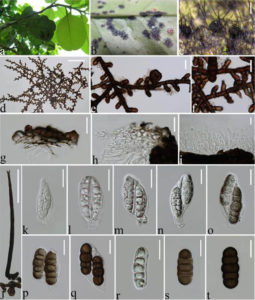Meliola citri-maximae X.Y. Zeng, K.D. Hyde & T.C. Wen, in Hyde et al., Fungal Diversity 80: 193 (2016)
Index Fungorum number: IF 552271; MycoBank number: MB 552271; Facesoffungi number: FoF 02253
Etymology – Referring to the host Citrus maxima (Burm.f.) Merr.
Epiphytes on the surface of living leaves. Colonies hypophyllous, scattered to dense, sometimes confluent. Hyphae superficial, brown, sub-straight, radiating outwardly, branched, septate, darker at septa, reticulate, with hyphal setae. Hyphal setae up to 320 μm long, dark brown, denticulate at the apex. Hyphopodia 20–22 × 8–10 μm (x̅ = 21 × 9 μm, n = 20), 2-celled, brown, spathulate, form one or two near the septa, alternate to unilateral, sometimes opposite antrorse. Sexual morph Perithecia up to 250 μm, superficial, sub-dense, globose to subglobose, thick-walled, with ostiole, without perithecial setae. Peridium two strata, comprising hyaline inner cells and dark brown outer wall of textura angularis. Hamathecium with evanescent paraphyses. Asci unitunicate, 2–3-spored, ovoid to ellipsoid when young, with short pedicel, asci wall attenuated or broken when mature, evanescent. Ascospores 42–48 × 16–21 μm (x̅ = 44 × 19 μm, n = 20), 2–3-seriate, cylindrical, hyaline at young state, becoming dark brown when mature, 3–4-septate, constricted and darker at the septa, middle cell a little larger, rounded at both ends, smooth-walled. Asexual morph Phialides 15–22(–25) × 7–9 μm (x̅ = 20 × 8 μm, n = 10), ampulliform, form one at the top of the hyphal cell, alternate or unilateral, sometimes mixed with capitate hyphopodia. Conidia undetermined.
Material examined – THAILAND, Chiang Rai, Horticulture Research Centre, on living leaves of Citrus maxima (Rutaceae), 12 March. 2014, Xiang-Yu Zeng (MFLU 14-0288, holotype).
Notes – Species of Meliolaceae found on Citrus include Amazonia butleri, Meliola amyridis, M. camelliae and M. citricola. Morphologically, the new collection is typical to the genus Meliola in having hyphal setae but differs from M. camelliae and M. citricola as it has 2–3-spored asci instead of 8-spored asci in M. camelliae and shorter setae, larger perithecia and larger ascospores than M. citricola. It is most similar to M. amyridis in having hypophyllous and dense colonies, alternate hyphopodia, and ascospore size but differs in having shorter setae, larger perithecia and hyphopodia. Phylogenetically, our new collection is related to M. brachyodonta and M. trichostroma. The sequence data of M. brachyodonta and M. trichostroma, which are unpublished, were provided by Pinho et al. (2013). However, these two species were found on Croton curranii (Euphorbiaceae) and Psidium guajava (Myrtaceae), respectively, which are on the different host families from this new collection. Although LSU phylogenies did not fully resolve the affinities of M. citri-maximae with other known Meliola species, we suggest it is a new taxon. Further analyses should target a more variable region, such as ITS or ß-tubulin, as the LSU gene is too conserved to differentiate species (Jeewon et al. 2002, 2003).

Figure 1. Meliola citri-maximae (MFLU14-0288, holotype). a Host leaves. b Colony on the surface of the leaf. c Ascoma on host substrate. d Hyphae with hyphopodia and phialides. e Hyphae with hyphopodia. f Hyphae with phialides. g Outer layer of peridium. h Inner layer of peridium. i Hamathecium. j Hyphal setae. k–q Asci from young state to mature state. r–t Ascospore from young state to mature state. Scale bars c, d = 200 μm, j = 100 μm, e–i, k–t = 20 μm.
